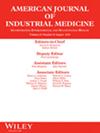COVID-19 Vaccine Hesitancy and Uptake Among California Workers in 2020–2022
Abstract
Background
Workplace interactions provide an opportunity for COVID-19 transmission, contributing to severe morbidity and mortality. While vaccines offer a key mitigation measure, hesitancy among certain populations may reduce the achievement of widespread immunity. This analysis characterizes COVID-19 vaccine hesitancy and uptake among California workers to inform interventions aimed at increasing vaccine confidence.
Methods
We analyzed data from the 2020–2022 adult California Health Interview Surveys (CHIS). We estimated survey-weighted COVID-19 vaccine hesitancy (2020) and unvaccinated frequencies (2021, 2022) with 95% confidence intervals (CI) among employed Californians by demographics and major occupational group. Multivariable logistic regression models examined vaccine intention and uptake by occupation, controlling for potential confounders.
Results
In 2020, 24.1% (CI: 23.1%–25.1%) of California workers were considered “vaccine hesitant,” and in 2021 and 2022, 43.1% (CI: 42.2%–44.1%) and 9.3% (CI: 8.5%–10.2%) of California workers were unvaccinated, respectively. Hesitancy was highest among Black and Hispanic workers, and vaccine uptake was lowest among these groups in both years. Workers in the Installation, Maintenance, and Repair and the Construction and Extraction occupations had the lowest odds of vaccine intention and uptake each year.
Conclusion
The aforementioned workers faced the highest burden of COVID-19 fatalities in 2020 and may be at higher risk of SARS-CoV-2 exposure, COVID-19 infection, and subsequent long-term health consequences. These trends should be considered when planning intervention programs to increase worker vaccine confidence and uptake. Further exploration of the reasons for low vaccine uptake and ways to minimize these gaps is paramount for both COVID-19 and impending pandemic threats.

 求助内容:
求助内容: 应助结果提醒方式:
应助结果提醒方式:


